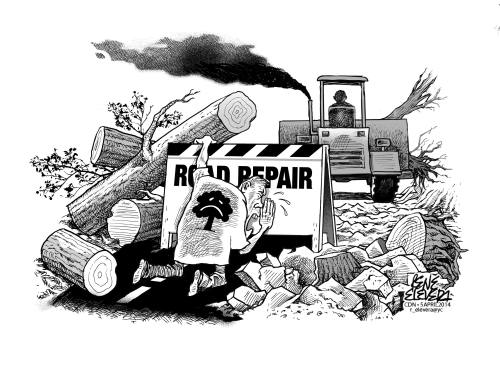
After years of suffering potholes and cracked lanes, this kind of government attention should be a happy problem.
It’s not.
The work supervised by separate district engineers of the Department of Public Works and Highways (DPWH) is not smoothly coordinated with the local government and other stakeholders.
You can tell that agencies are not talking with one another, or with the public it serves, when confused motorists agonize over detours without clear signs or information about alternate routes to take and there are no traffic enforcers helping sort out the mess on the road, much less a functioning signal light.
Taxi drivers end up arguing with passengers, who are caught by surprise by unusual directions the cab takes just to avoid getting stuck in traffic.
To catch a flight out of the airport in Mactan these days means having to second guess road conditions and traffic in all three cities, then doubling your usual leeway time for getting there.
Mayors are angry because they are merely notified when a road repair or “improvement” project is about to start, with little time to prepare the riding public with rerouting schemes or an information drive.
(Work was postponed on Serging Osmeña Road, for example, because malls and commercial establishments protested that the last-minute road closure, timed for a payday sale, was disastrous timing.)
Yes, it’s summer, the best time to do road maintenance because its the dry season.
However, the question on everyone’s mind, after stewing in a hot jeepney or car, is “Why do they insist on doing all the road repair simultaneously?”
Ask an irritated taxi driver, and he’ll tell you it has everything to do with money, not public service: “Pangwarta lang ang ila.” (They’re just out to make money.)
Projects below P50 million are implemented by the local DPWH district engineer, which is the case for many of the ongoing road rehab works. Beyond P50 million, it’s the lookout of the DPWH regional office.
While national roads are located in nearby territories, they don’t stem from a single, integrated plan for Metro Cebu but roll out in piecemeal fashion. Three cities, three plans. Each has a district engineer acting from his or her own list of targets.
The splintered approach has something to do with how the DPWH is measured.
In a recent forum on the Mega Cebu Project, which is a private sector-led movement to define and carry out a coherent vision of sustainable growth for a rapidly urbanizing Metro Cebu, a disturbing insight emerged.
They found out that the main performance indicator of DPWH districts and the regional office is its speed of spending.
In a bizarre sense of efficiency, a DPWH district is rated as doing a good job, not by the kilometers of roads it paves or the traffic ratio it achieves, but by how fast it can use up its alloted infrastructure budget.
Unused budgets get sent back to the Manila central office at the end of the year. Nobody wants that – especially the contractor.
The annoyed taxi driver was right.
In the DPWH, the priority is spending fast and getting all those public works contracts done.
The frenzy of road “improvement” will make this a gruelling summer indeed.